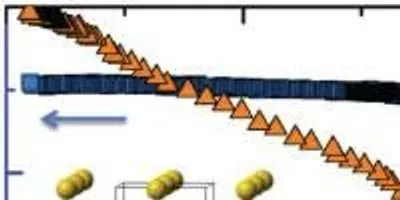 A change of Hall and Seebeck effects point to large Fermi surface modification at the structural transition, preventing superconductivity at low temperatures. The change in the Fermi surface topology has been confirmed by angle-resolved photoemission spectroscopy.Image courtesy of Oak Ridge National LaboratoryThe paper, published in Physical Review Letters, focuses on a calcium-iron-arsenide single crystal, which has structural, thermodynamic and transport properties that can be varied through carefully controlled synthesis, similar to the application of pressure. To make this discovery, researchers focused on how these changes alter the material’s Fermi surface, which maps the specific population and arrangement of electrons in materials.
A change of Hall and Seebeck effects point to large Fermi surface modification at the structural transition, preventing superconductivity at low temperatures. The change in the Fermi surface topology has been confirmed by angle-resolved photoemission spectroscopy.Image courtesy of Oak Ridge National LaboratoryThe paper, published in Physical Review Letters, focuses on a calcium-iron-arsenide single crystal, which has structural, thermodynamic and transport properties that can be varied through carefully controlled synthesis, similar to the application of pressure. To make this discovery, researchers focused on how these changes alter the material’s Fermi surface, which maps the specific population and arrangement of electrons in materials.
“The Fermi surface is basically the ‘genetic code’ for causing a certain property, including superconductivity, in a material,” said Athena Safa-Sefat of the Department of Energy’s Oak Ridge National Laboratory, which led the research team. “We can make different phases of this material in single crystal forms and measure their structure and properties, but now we have Fermi surface signatures that explain why we can't induce superconductivity in a certain structural phase of this material.”
Superconducting wires conduct electricity without resistance and could save the nation billions of dollars per year by virtually eliminating transmission losses on the grid, or they can be used to make compact, light and powerful motors and generators. This particular material is of special interest because it adds critical knowledge to the field of superconductivity that will ultimately allow such widespread applications.
The lead author of this paper, Krzysztof Gofryk, who did this work as a post-doctoral fellow at ORNL, showed how the interplay of structure and magnetism affected the Fermi surface and hence the electronic properties.
In calcium-iron-arsenide, the bulk superconducting state is absent because of the large Fermi surface modification at the structural transition.
This work represents a significant step forward for understanding this material's rich phase diagram and causes of superconductivity, Sefat said.
Other authors of the paper, titled “Fermi-Surface Reconstruction and Complex Phase Equilibria in CaFe2As2,” are ORNL’s post-doctoral fellow Bayrammurad Saparov and scientists from Los Alamos National Laboratory and Dresden University of Technology. The paper is available at http://arxiv.org/abs/1404.1095.
This research was funded by DOE’s Office of Science and by LANL’s Laboratory Directed Research and Development program.
The paper, published in Physical Review Letters, focuses on a calcium-iron-arsenide single crystal, which has structural, thermodynamic and transport properties that can be varied through carefully controlled synthesis, similar to the application of pressure. To make this discovery, researchers focused on how these changes alter the material’s Fermi surface, which maps the specific population and arrangement of electrons in materials.
To continue reading this article, sign up for FREE to

Membership is FREE and provides you with instant access to eNewsletters, digital publications, article archives, and more.












